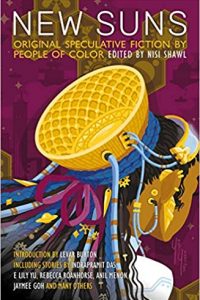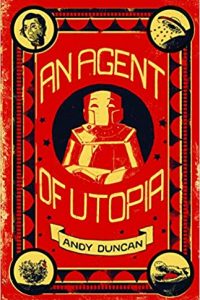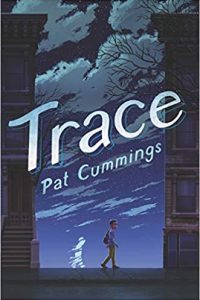Just a Very Bad Wizard: A Review of Oz the Great and Powerful
 by Gary Westfahl
by Gary Westfahl
For those who don’t have time to read a long-winded review, the essential message can be presented quickly: if you love bright colors, impressive visuals, and arresting uses of 3-D technology, one can enthusiastically recommend watching Oz the Great and Powerful as a film that offers exactly what you’re looking for. However, if you want to watch a film with a satisfying narrative that recalls the classic The Wizard of Oz (1939), which is what this film is manifestly promising, you would better off revisiting the original film or, if you’ve never seen it, watching Disney’s earlier Oz film, Return to Oz (1985), which does a much better job of recapturing the spirit of the 1939 film.
As I proceed to explain myself at greater length, it is a sad commentary on contemporary films that this review, like so many others, will sound more like an autopsy, earnestly endeavoring to analyze what brought about the film’s demise for people who have not already wiped the film from their memories and turned their attention to next weekend’s more promising releases. It shouldn’t be that way. After all, entertaining people is what Hollywood is supposed to be very good at, and never before in human history have so many people devoted so much time and so much money to their efforts to do exactly that. Yet again and again, as in the case of Oz the Great and Powerful, canny producers seize upon an idea that can’t miss (“hey, let’s do a prequel to one of the most beloved motion pictures ever made”), recruit A-list talents (director Sam Raimi, actors James Franco, Michelle Williams, and Rachel Weisz), spend vast sums of money ($200,000,000), and somehow produce a film that inspires even a favorably inclined viewer, who entered the theatre eager for enjoyable entertainment, to start looking at his watch instead of the screen.
To be sure, one day after its release, it may be premature to liken Oz the Great and Powerful to a corpse that must be briefly studied before being consigned to the Mausoleum of Forgotten Films. As already suggested, the film does have marvelous scenes that strive to be breathtakingly beautiful and sometimes succeed, and since no script carefully prepared for a big-budget movie can misfire on every page, there are some moments that will provoke laughter or arouse powerful emotions. Perhaps this film will find an appreciative audience and earn lots of money for the Walt Disney Company; after all, in a world that made Avatar (2009) (review here) the highest-grossing motion picture of all time, nothing is impossible (“as long as you believe,” a character from this film would annoyingly add). But if I were a gambling man, I would bet instead that Oz the Great and Powerful will join Mars Needs Moms (2011) (review here) and John Carter (2012) (review here) as yet another of Disney’s early-March fantasy film failures.
As one similarity linking these three films, they all began by choosing appealing source material; here, while the film is officially based only “on the works of L. Frank Baum,” and while it does borrow some elements from portions of Baum’s The Wonderful Wizard of Oz (2000) that did not figure in its most famous film adaptation, like the names of Glinda’s subjects, the Quadlings, and the country of china people, this film is actually an unacknowledged adaptation of the 1939 film. This is signaled at the very start when we are told that the story begins in 1905, five years after Baum’s novel was published, but a year chosen to give Franco’s youthful Oscar Diggs 34 years to grow old enough to look like Frank Morgan’s elderly Wizard in 1939. It is also immediately clear that this film will be following the pattern of the 1939 film by offering a black-and-white prologue, set in the real world of Kansas, where the protagonist, circus magician Diggs, interacts with versions of the characters he will later meet in the fantasy world of Oz. So, Diggs’s assistant Frank (Zach Braff), whom he disparagingly calls a “trained monkey,” resurfaces as the flying monkey Finley, his ex-girlfriend Annie (Williams) becomes the good witch Glinda, and a disabled girl in his audience (Joey King) reappears as the China Girl.
But this time, something is awry: the purpose of the 1939 prologue was to establish that all of Dorothy’s adventures in Oz were merely her dream, in which she borrowed people from her everyday life to populate her imaginary realm, and the film logically concludes with Dorothy reawakening in black-and-white Kansas to reencounter the real people who had inspired her fantasies. Yet audiences already know that Oz the Great and Powerful cannot have a similar ending. As a practical consideration, any prequel to The Wizard of Oz must leave Diggs in Oz to eventually meet Dorothy, so he cannot fly away from Oz and return to Kansas as Dorothy does. More broadly, we have long since passed the time when extravagant fantasies had to be presented to a skeptical world as idle dreams which might be briefly enjoyed but must ultimately be rejected because “there’s no place like home.” Today, people embrace fantasy as something important, even as something that is and should become real, and the message reverberating throughout young people’s education and entertainment is that they should get as far away from their homes as possible in order to pursue their wildest dreams. Any modern version of The Wizard of Oz, for that reason, must end as this film does, with a protagonist who has become a permanent inhabitant of the fantasy world that he so fervently sought. (As another example, consider the conclusion of the aforementioned Avatar, another film that Oz the Great and Powerful, as will be discussed, sometimes resembles.) This is all fine, but what, then, is the point of the prologue? Here, Finley, Glinda, and the China Girl are real, they are not Diggs’s distorted dreams, so why should they resemble people in Kansas? And everything that the prologue tells us about Diggs’s character and aspirations is revealed again, and again and again, once he reaches Oz; one could start watching the film the minute it shifts to color and understand everything perfectly well. As was the case in John Carter, this overlong prologue undoubtedly seemed cute and clever to its creators, but for audiences it is pointless and tedious.
Simply chopping off the prologue, though, would not address the other problems with this film, which relate to the plight of anyone trying to produce a blockbuster film: they have too much time on their hands, and too much is at stake. It was paradoxically advantageous for the makers of The Wizard of Oz that they regarded the film as nothing special, just another major release on the MGM schedule that had to be finished quickly to allow performers and technicians to move on to the next project, and that they firmly aimed the film at an audience of children. They did not have the time, or inclination, to ponder the question: “what can we do to make this film appealing to every single audience imaginable?” No one, for example, ever suggested, “hey, women like love stories, so why don’t we add a little romance to the script?” Indeed, in a film for children, it would have been odd and disconcerting to suggest, even subtly, that Dorothy was developing a crush on the Scarecrow, or that Glinda the Good Witch was getting it on with the Wizard of Oz. In the case of Oz the Great and Powerful, however, it is painfully clear that the filmmakers asked precisely those questions and revised the script accordingly. Thus, while the Wizard was always a lovable charlatan, this film makes him a ladies’ man as well, a cad who likes to love ‘em and leave ‘em, and all three of its witches are transformed into beautiful, seductive women who at one point are positioned to function as his romantic interest, generating intermittent suspense about which one will finally end up in his arms. In effect, the film is adding an adult subplot to a children’s film, and quite unsurprisingly this doesn’t really work. (The makers of the 1939 film were wiser in this respect, since they briefly considered casting Gale Sondergaard as a sexy Wicked Witch of the West but ultimately opted for Margaret Hamilton’s ugly old hag.)
Another incongruous aspect of the film is very brief, but jarring nonetheless. In the 1939 film, the characters would periodically pause to break into song, a once-common film convention that can make modern audiences feel uncomfortable; one should not fault Raimi for avoiding such interludes, and Return to Oz demonstrated persuasively that one does not need songs to replicate the magic of the original film. But Oz the Great and Powerful breaks the pattern in one scene; when this film’s Munchkins are belatedly introduced and described as wonderful singers, they immediately start singing what one hopes is a deliberately awful song (surely, composer Danny Elfman could have done better). The Wizard quickly gets them to stop singing, conveying that this film’s serious business of battling wicked witches will not be disrupted by such silliness. However, since so much of this film is a visual homage to The Wizard of Oz, striving to perfectly duplicate its Day-Glo ambience, what is the point of also making fun of it? But one can almost imagine the story conference when somebody said, “Hey, we can’t just make the film for the people who loved the MGM classic; we should throw something in for everybody who hated it too!” And nobody responded that it is sort of impossible to simultaneously please people who adore a movie and people who despise a movie, and trying to do so can only serve to alienate those in one camp or the other. (For the record, a team of no less than six songwriters did attempt, and fail, to write one deliberately good song for the closing credits, the instantly-forgettable “Almost Home,” probably because someone decided that, if nothing else about the film proved memorable, they might at least try to get an Academy Award nomination for Best Original Song.)
In manners so myriad that a single review cannot provide a comprehensive survey, Oz the Great and Powerful reflects decisions made not as a matter of intelligent story-telling, but of compromising, touching all the bases, and respecting everybody’s input. One small but telling example: in the course of the film, not counting the witches, the Wizard spends most of his time with two characters, Finley and the China Girl, so one would expect the film’s conclusion to focus on those two stalwart companions. But someone must have felt that this would have been insufficiently fulfilling, so two other minor characters were abruptly elevated to the status of the Wizard’s BFFs to receive equal attention. If one thinks this is a minor matter, imagine the emotional impact of Dorothy’s departure from Oz in the 1939 film if, along with the Scarecrow, the Tin Man, and the Cowardly Lion, she had also paused to bid a tearful farewell to the members of the Lollipop Guild. Somebody also thought that, in addition to references to the 1939 film, it might be clever to borrow from some earlier Walt Disney productions, for no particular reason; thus, the poisoned apple from Snow White and the Seven Dwarfs (1937) puts in an appearance, and the Wizard gets to emulate Scrooge McDuck by diving into a room filled with gold coins.
An additional facet of the 1939 film’s charm was that, despite a few big production numbers, its moments of dramatic triumph were personal, even intimate: Dorothy’s accidental “liquidation” of the Wicked Witch of the West with a bucket of water, Toto’s unveiling of the Wizard’s true nature, and the final discovery of the true power of the ruby slippers. But in a contemporary blockbuster, of course, everything has to be Big, Big, Big, so one could readily anticipate that the film’s final scenes would not involve the Wizard struggling against the witches, but rather, the Wizard assembling an army to oppose another army led by the witches. Only the thematic underpinnings of the climactic battle are interesting. In the similar conclusion of Avatar, the transplanted hero of the fantasy world commands a horde that represents the natural world successfully overcoming the evil technology of the humans. Here, the natural magic of Oz is mostly evil, and the transplanted hero must defeat it by employing the benign technology of good old American ingenuity. Surprisingly, then, one found the natural message of fantasy in James Cameron’s science fiction film, while this fantasy film is conveying the natural message of science fiction. Without providing any specifics about the Wizard’s successful strategy, one also observes that one of his mightiest weapons provocatively proves to be the technology of motion pictures; almost literally, movies become Oz’s most powerful form of magic.
In this respect, as in others, one wonders if the filmmakers were really talking to themselves. That is, if you begin to suspect that, despite your best efforts, you are most likely producing a terrible bomb, you might respond by giving yourself some pep talks: don’t despair, don’t give up hope, you’re the master of the world’s greatest medium, motion pictures, and all you have to do is have faith, believe in yourself, and anything is possible. Such rhetoric comes easy to anyone who has watched this film, since they have heard so much of it. And this is another way that contemporary films often go astray. Yes, The Wizard of Oz did include a rather conservative message about restraining one’s imagination and appreciating the simple pleasures of home life, but it only cropped up a few times; the film didn’t keep pounding it into the heads of the audience every five minutes, so it didn’t really bother anybody. Today’s filmmakers, as if addressing a half-deaf child, keep picking up their megaphones to shout out their message one more time, in words of one syllable, so that everyone soon gets tired of hearing it.
Considering the many deficiencies of this film, and those of the many other disappointments that plague today’s theatres, one is finally driven to some sobering realizations about the realities of contemporary filmmaking. First, after a century of experimentation, the film industry has developed a vast number of reliable rules that can lead to successful films. Second, whenever a lot of money is on the line, filmmakers feel compelled to follow each and every one of those rules in each and every one of their films, more often than not resulting in a disaster. Third, even if they fully understand the problem, filmmakers may continue to make the same mistake, again and again and again, because it represents the ultimate form of ass-protection: for if their latest film bombs, the director and writers can always tell their financial supporters, “hey, you can’t blame us, because we followed all of the rules.” So it may well be that exactly one year from now, I will be writing a scathing review of Disney’s March, 2014 attempt to produce a fantasy film blockbuster, patiently explaining that the film tried to be too many different things to please too many different people and thus failed to achieve anything or to please anybody. One can only hope that someday, filmmakers will see the light, and start taking some chances and breaking some rules, so that I can once again work as a reviewer, not a coroner.







